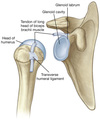S7) The Shoulder Flashcards
(85 cards)
There are two types of muscles of the shoulder. Identify and describe them
- Extrinsic muscles originate from the torso and attach to the bones of the shoulder (clavicle, scapula or humerus)
- Intrinsic muscles originate from the scapula and/or clavicle and attach to the humerus
Identify the 6 intrinsic muscles of the shoulder
- Deltoid
- Teres major
- Supraspinatus
- Infraspinatus
- Subscapularis
- Teres minor
Describe the structure and function of the deltoid muscle
- Structure: consists of anterior, middle and posterior parts
- Action: shoulder flexion (anterior fibres), shoulder extension (posterior fibres), abduction 15-90o (middle fibres)

State the origin and attachment of the deltoid muscle
- Origin: scapula and clavicle
- Attachment: deltoid tuberosity on lateral surface of the humerus

What innervates the deltoid muscle?
Axillary nerve

Describe the structure and function of the teres major muscle
- Structure: forms inferior border of the quadrangular space
- Function: adduction, medial rotation

State the origin and attachment of the teres major muscle
- Origin: posterior surface of the inferior angle of the scapula
- Attachment: intertubercular groove of the humerus

What innervates the teres major muscle?
Lower subscapular nerve

What are the rotator cuff muscles and what do they do?
- The rotator cuff muscles are a group of four muscles that originate from the scapula and attach to the humeral head
- Collectively, the resting tone of these muscles acts to ‘pull’ the humeral head into the glenoid fossa stabilising the glenohumeral joint
Identify the 4 rotator cuff muscles

State the function of supraspinatus muscle

Abducts the arm 0-15° and assists deltoid for 15-90°

State the origin and attachment of the supraspinatus muscle

- Origin: supraspinous fossa of the scapula
- Attachment: greater tubercle of the humerus

What innervates the supraspinatus muscle?

Suprascapular nerve

State the function of the infraspinatus muscle

Lateral rotation

State the origin and attachment of the infraspinatus muscle

- Origin: infraspinous fossa of the scapula
- Attachment: greater tubercle of the humerus

What innervates the infraspinatus muscle?

Suprascapular nerve

State the function of the subscapularis muscle

Medial rotation

State the origin and attachment of the subscapularis muscle

- Origin: subscapular fossa on the costal surface of the scapula
- Attachment: lesser tubercle of the humerus

What innervates the subscapularis muscle?

Upper and lower subscapular nerves

State the function of the teres minor muscle

Lateral rotation

State the origin and attachment of the teres minor muscle

- Origin: posterior surface of the scapula
- Attachment: greater tubercle of the humerus

What innervates the teres minor muscle?

Axillary nerve

Where extrinsic muscles of the shoulder found?
Extrinsic muscles of the shoulder are located in the back aka. superficial back muscles
Which two muscles are in the superficial layer of the shoulder?
- Trapezius
- Latissimus Dorsi































































